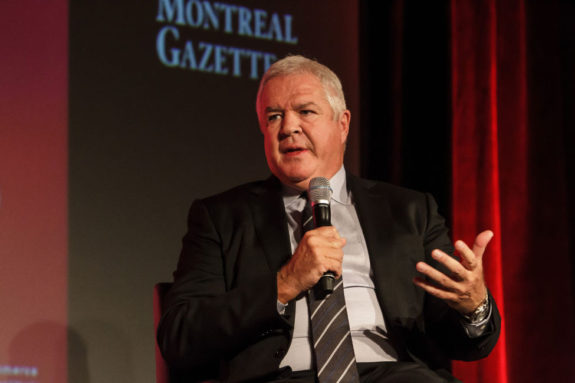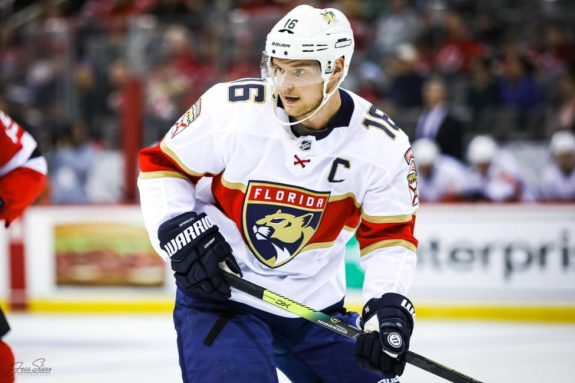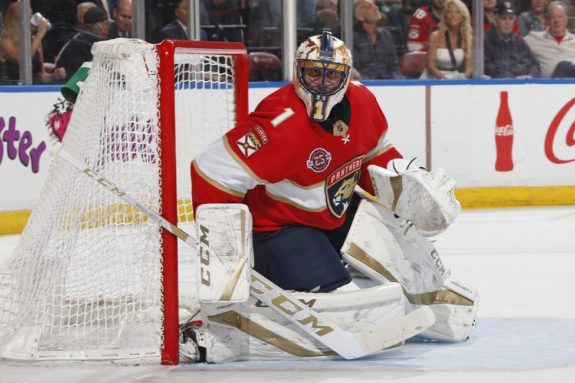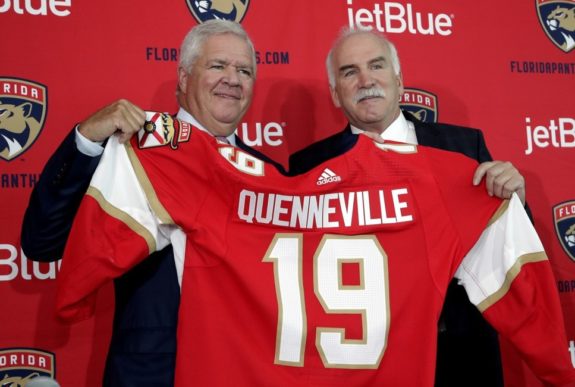Few NHL general managers have had as much leeway as Dale Tallon of the Florida Panthers. Approaching 10 years with the organization, he’s actually gotten two tenures, disappointing each time.
Tallon vs. Bowman
On the latest occasion, Tallon took over for Tom Rowe, who got demoted from the position in 2017. Rowe had taken over for Tallon one year earlier after the latter had gotten promoted to president of hockey operations. The changes haven’t made much difference as far as the on-ice product is concerned, unfortunately.

Tallon initially joined the Panthers as GM after having gotten demoted from that same position by the Chicago Blackhawks, by all appearances over a clerical error. Under Tallon, the Blackhawks obviously thrived. Starting the season Tallon became Blackhawks GM in 2005, they continually improved points-wise in the standings, culminating in a 2010 Stanley Cup win.
While Tallon had already been demoted at that point, under his guidance the Blackhawks drafted Jonathan Toews and Patrick Kane. As a result, he is considered to be the engineer of that 2010 championship team and not successor Stan Bowman. Even though Bowman deserves credit himself as one of the top GMs in the league with three official Cup wins, Tallon is also seen as having laid the groundwork for the 2013 and 2015 championships too.
Tallon Can’t Replicate Blackhawks Success
So, it wasn’t a surprise to see Tallon land on his feet eventually with the Panthers. The idea was that he could parlay his success managing the Blackhawks into similar success managing the Florida-based franchise. Lightning can only strike once, it would seem. Pun very much intended.
Following the same formula as he did with the Blackhawks, Tallon hit home runs with a couple of draft picks, namely a winger (Kane) and center (Toews): Jonathan Huberdeau (No. 3 overall in 2011) and Aleksander Barkov (No. 2 overall in 2013). That’s about where the similarities end, though.

From 2010-2014 Tallon had the benefit of two other high Panthers picks over the same time five-draft time span he had in Chicago. Tallon obviously whiffed on defenseman Erik Gudbranson (No. 3 overall in 2010), but he did connect on fellow-blue-liner Aaron Ekblad (first overall in 2014). Granted, he could have had Leon Draisaitl instead, but a stud blue-liner better suited his team’s needs at the time. Ekblad was the best one available.
Nevertheless, the additional help didn’t do much. Whereas the Blackhawks began to gel right away under Tallon, his high-profile Panthers draft picks only contributed to a single playoff appearance in 2016. Granted, the Panthers also made the playoffs in 2012 under him, but Huberdeau, the first of the picks in question, only made the team for the 2012-13 season.
Tallon’s Failed First Impression in Florida
While Tallon wasted little time making moves, reshaping the Panthers after having gotten hired in May 2010, few of his early transactions resulted in what you would call franchise-defining acquisitions. He did ship out Nathan Horton and Keith Ballard in separate deals, but the returns, while decent in theory, were underwhelming in practice.
Tallon got Steve Bernier, Michael Grabner, who the Panthers soon lost to the New York Islanders via waivers, and a first-round pick that would turn into Quinton Howden for Ballard and Victor Oreskovich. For Horton and Gregory Campbell, he got Dennis Wideman and two picks.
One of those picks included No. 15 overall in 2010, which would turn into Derek Forbort, but it got flipped for Nos. 19 and 59 that same year (Nick Bjugstad and Jason Zucker). He flipped the pick that would become Zucker for two more picks that same year (No. 69 Joe Basaraba and N. 99 Joonas Donskoi). Of all the players listed in the paragraph, Zucker has unfortunately for Tallon turned into the biggest success story of the bunch.
Tallon only started making progress building the Panthers back up in the summer of 2011, one year on the job. He got defenseman Brian Campbell from the Blackhawks for Rostislav Olesz, which was a clear win. He also traded for Kris Versteeg and signed Tomas Fleischmann, both of whom, along with Stephen Weiss, formed the backbone of the Panthers’ offense en route to their first playoff appearance in over a decade.

There should be no taking that accomplishment away from Tallon, even if it ended in disappointment, with the first-round, seven-game loss to the New Jersey Devils. After all, he successfully helped lead the Panthers to their first-ever division title that season.
The problem is the winning season gave the illusion of lasting success, when none of his acquisitions up to that point, via free agency, trade or the draft, were lasting in nature. Campbell was 32 at the time of the trade, Fleischmann had only one more productive season left in him before he exited his prime and Versteeg didn’t even give them that as he got in only 10 games in 2013 due to a knee injury before getting traded early in 2013-14.
Ultimately, as secondary scoring options on their previous teams, Versteeg and Fleischmann were little more than short-term solutions. Tallon only really made his first trade with serious long-term vision in 2015 when he traded Jimmy Hayes to the Boston Bruins for Marc Savard’s contract and a then-24-year-old Reilly Smith. However, he negated it all with his generosity to the Vegas Golden Knights at the 2017 Expansion Draft, when he gave up both Smith and Jonathan Marchessault, two players who have been key pieces for their new club.
Panthers Still Have Goaltending Problems
Furthermore, goaltending, the position that’s the most key of all, remains one in flux. Tallon addressed it by acquiring an aging Jose Theodore as a stop-gap measure for the 2011-12 season. Once Theodore’s deal expired two seasons later, Tallon turned to an even-older Tim Thomas. When that predictably didn’t work out, they traded away their supposed goaltender of the future in Jacob Markstrom in a deal with the Vancouver Canucks to re-acquire Roberto Luongo, who was no spring chicken himself.

Luongo admittedly stabilized the situation, as the Panthers won another division title in 2016 (only to lose to the Islanders in six games in Round 1). At that point, Tallon got promoted (because mission accomplished, apparently). However, under Tallon (and technically Rowe for a season) the goaltending position still fell into a state of disrepair from a developmental standpoint.
Before Tallon picked goalie Spencer Knight in last summer’s first round, their last picks at the position came literally four drafts earlier. Considering Luongo’s age, that speaks to major mismanagement.
In fact, none of the goaltenders the Panthers have picked during Tallon’s (two) tenure(s) have panned out. Since 2010, the Panthers have picked five goalies excluding Knight. They have literally combined for 25 NHL games, all played by Samuel Montembeault, who has effectively become a third-stringer on the team’s depth chart, behind the just-signed Sergei Bobrovsky and free-agent-signee Chris Driedger, who has developed into a diamond in the rough, albeit after a small sample size of a single season in a Panthers uniform.
Put it this way: It says a lot about your foresight and organization as a whole when:
- Out of desperation, you draft your first goalie in four years at No. 13, when their developmental curves are notoriously hard to predict.
- Literally 10 days later, you sign a 31-year-old goalie (Bobrovsky) exiting his prime to a seven-year, $70 million deal.
- That goalie proceeds to lay a massive season-long egg.
- As a result, your hopes have been effectively pinned on a minor-league 25-year-old goalie with three career NHL games prior to this season.
Now, barring a miraculous turnaround on Bobrovsky’s part, it’s pretty much up to Driedger to bridge the gap in between him and Knight. It has to be, due to the Panthers’ self-inflicted cap damage. It’s like Tallon inherited all of the Blackhawks’ cap issues, but none of their playoff success.
Tallon’s Second Five-Year Plan
Credit where it’s due, Tallon’s Panthers have iced a few competitive teams even if they didn’t make the playoffs. There hasn’t been the same progression as there was with the Blackhawks, though.
When you’re nine years in and hailing the signing of head coach Joel Quenneville as a first step to just make the playoffs again, you’ve made a few missteps instead. When you’re ending Year 10, the sum of two hypothetical five-year plans, in a worse position in 11th place, more changes are obviously needed… arguably at the top.

Maybe these things take time, but there is such a thing as too much. With regard to Tallon, the Panthers shouldn’t have to hope that the third time is a charm. He should be out of slack by now.